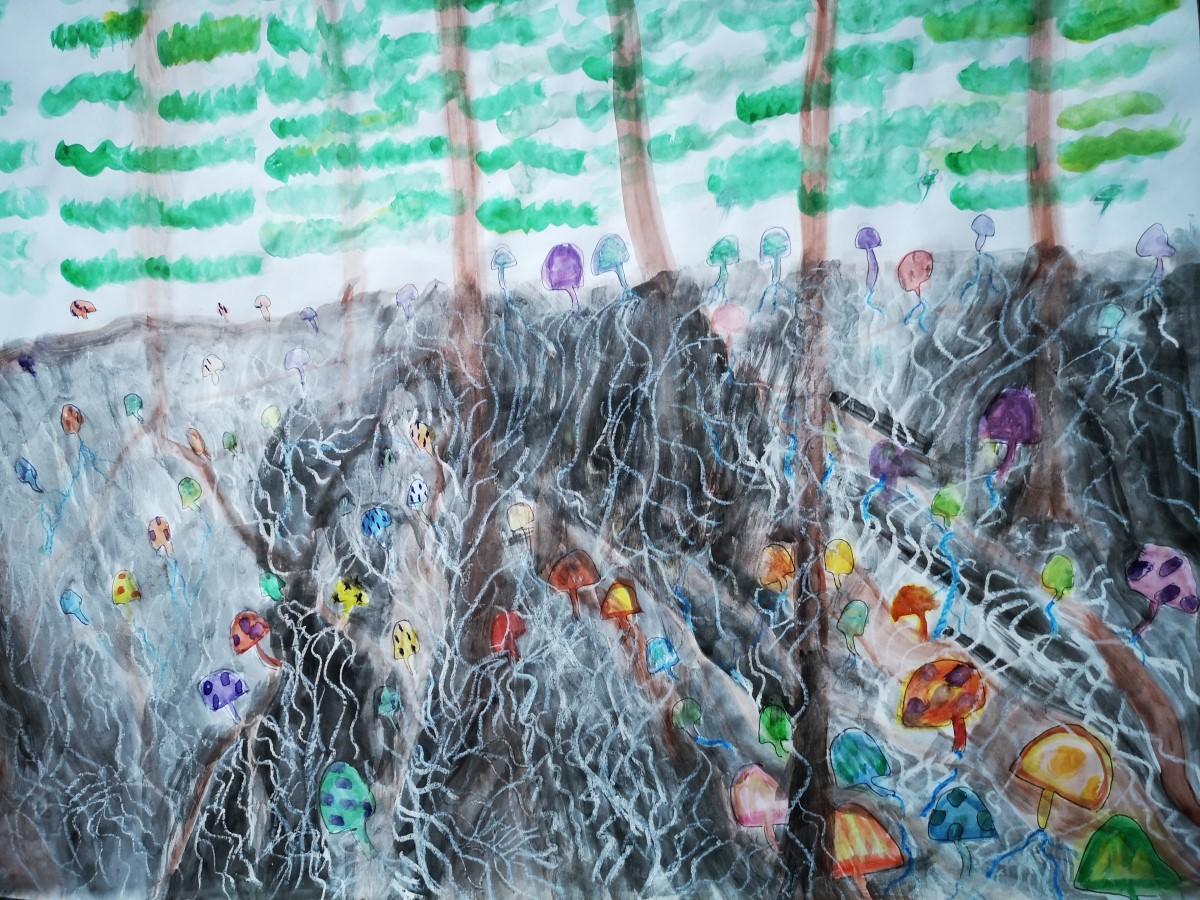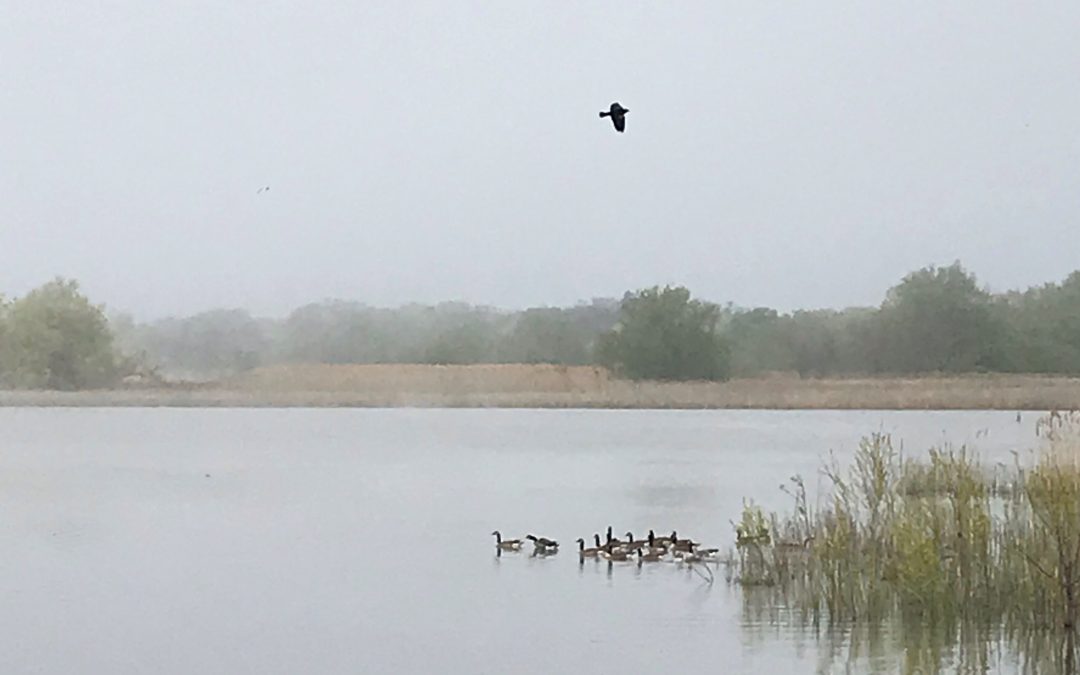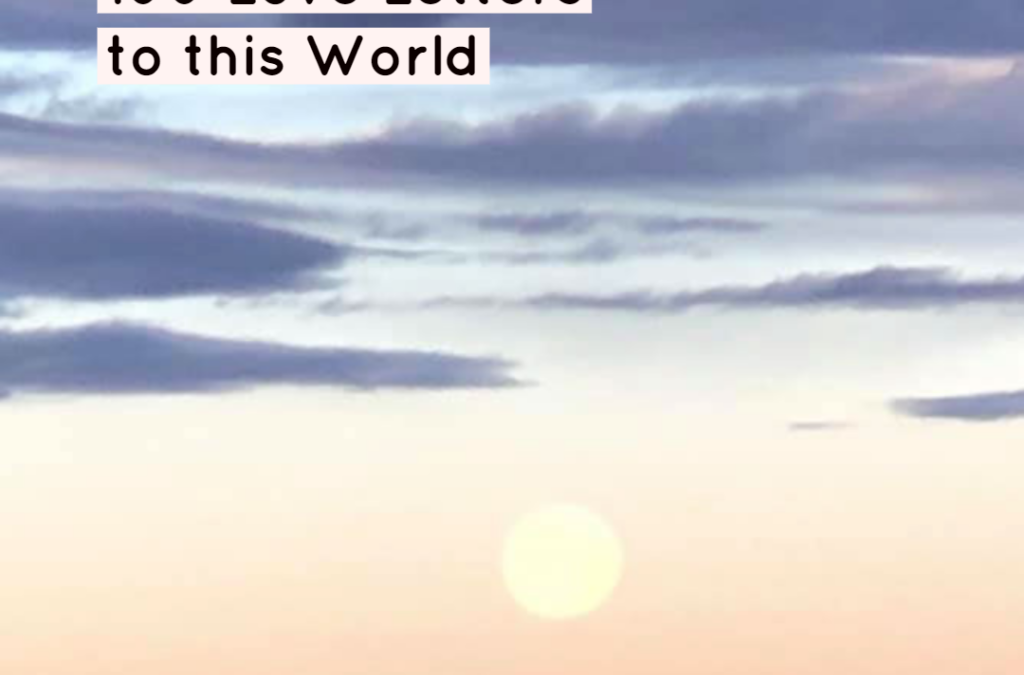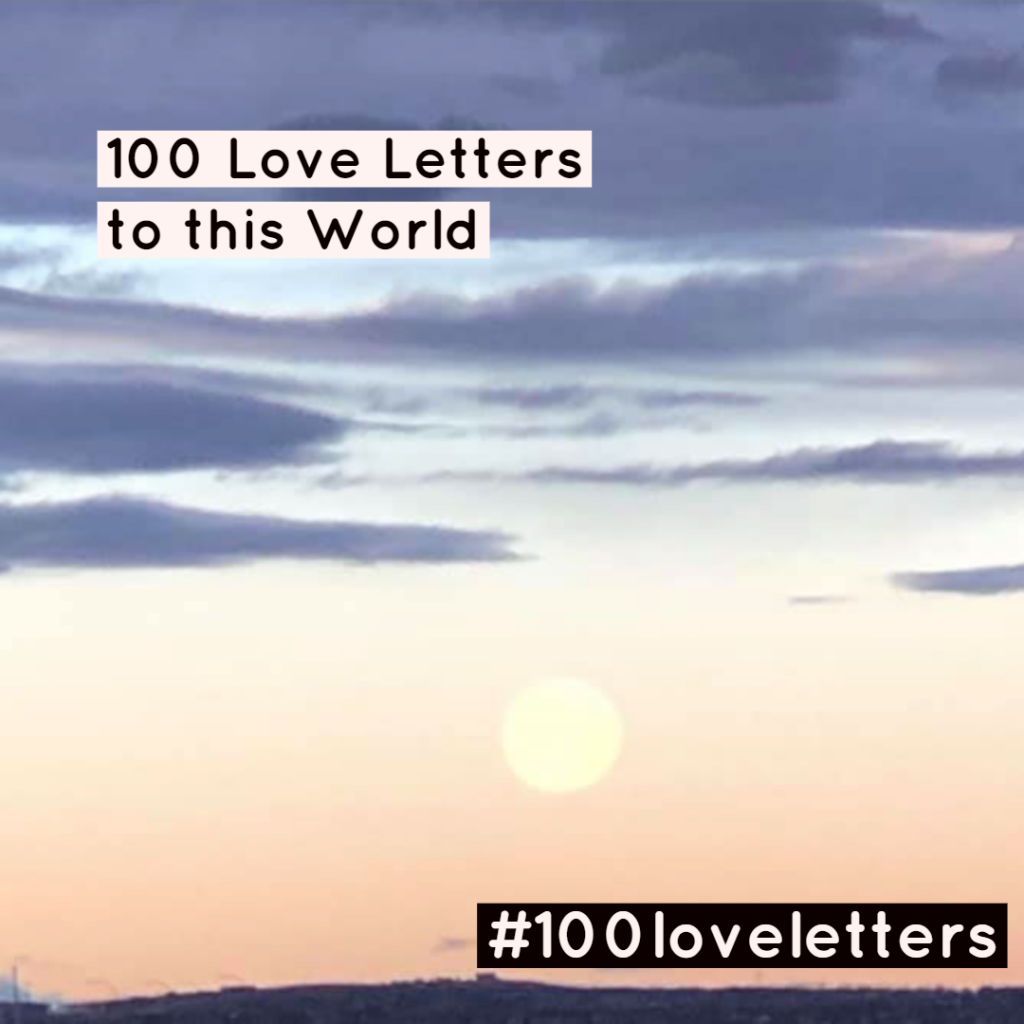
All the sudden, mushrooms

The right rain comes and all the sudden, mushrooms.
A letter for our friends in the United States, following the 2020 presidential election.
From Lindsey Boyes and Tiffany Sostar
Artwork: mycelium and mushroom 2 by Lindsey Boyes
Download this letter as a PDF here, or email Tiffany to have a physical copy mailed to you. You can support more of this work at Tiffany’s Patreon.
“Mushroom Mycelium represent rebirth, rejuvenation, regeneration.”
– Paul Stamets
A small imagining, based on the metaphor of mycelium in forests. In this imagining, we are the trees.
Mycelium are fungal material, spread throughout soil and other substrates, which can fruit into mushrooms under the right circumstances. Mycelium can be tiny, or, as the Armillaria in Oregon, vast and ancient. Mycelium not only break down dead matter, they also distribute resources across ecosystems. The mycelium network within a forest can link trees across a vast distance, sharing nutrients from one part of the forest to another.
- What is the soil in which you find yourself?
(Your social context, your environment.) - Does this soil feel rich and nutrient-dense, or does it feel depleted?
(Are you nourished and supported by your social context?) - Do you remember a time when you were in different soil?
(Have you ever found yourself in a different social context?) - Who is in this soil with you? Who is in your forest?
(Who is alongside you? Perhaps these are cherished companions, perhaps they are not. Forests are places of magic, and also danger, after all.) - What else is present in the forest?
(Are there birds, squirrels, bears, bees, mosquitoes? What other non-tree / non-human companions are in your forest?) - Who are you connected to across distance?
(What companions do you cherish and stay connected to? These may be living or not, they may know you in return or not. The mycelium network is magical because it can connect us in seemingly impossible ways.) - What nourishment is shared across your connection?
(What do these connections make possible – what do they offer that you do not receive in your immediate environment?) - What information is shared?
(What have you learned from these distant connections?) - What do the mycelium share from you, out to other parts of the network?
(What contributions have you made, what has your existence made possible in the lives of others?)
Dear friends,
We (Lindsey and Tiffany) are writing this letter from Calgary, Alberta, in so-called Canada. From Blackfoot Confederacy (Siksika, Kainai, Piikani) and Stoney-Nakoda (Wesley, Chiniki, Bearspaw) and Tsuut’ina land. Métis land. From the place where the Bow meets the Elbow river.
This is beautiful, breathtaking land.
We wonder about the land that you are on.
Are there trees? Rivers? Mountains?
What do you see when you look out the window, when you step out your door? What do you smell? What do you hear?
What is the landscape, and what are the plants and animals that you share space with?
What is your relationship with the land you’re on?
In an Indigenous Counselling and Trauma Work course, Cree/Métis therapist and academic Karlee Fellner taught Tiffany that the land is old enough, strong enough, wise enough to help us hold our pain, no matter how vast that pain is. As we write this letter, we are thinking about the pain that exists following the events of the last years.
The land we write this from, and the Indigenous people on this land, and every marginalized community here, is currently threatened not only by the conservative government in power in this province, but also by Canada’s ongoing commitment to extractive and exploitative relations with land and people.
We’re sharing this context because we want to be clear that we recognize as much racism, as much white supremacy, as much racial capitalism and neoliberalism here in our country, in our province, in our city, as we see happening in the US. We are not writing from a position of distance or superiority, but from a position of shared struggle against these oppressive discourses and systems. And, as white settlers, also from a position of complicity with these discourses and systems.
We planned to write this letter before the results of the 2020 presidential election came in, because we wanted to offer some care to our friends in the US. But we found ourselves, like so many other folks, slowed down by the thick mud of distraction and doomscrolling through our social media feeds. So, instead, we are writing this after Joe Biden has been named president-elect, after the wave of celebration and the deep collective sigh of relief. (We were relieved, too!)
This little document contains some of our hopes for you, and reflects some of our hopes for ourselves. It also contains some art, a little recipe, and a few reflection questions that we have found helpful for ourselves. The document comes out of our work together in the Unexpected Light speculative fiction and narrative therapy course, and we hope that this document can be a tiny invitation to imagine more just, more liberated, more possible futures.
We wonder about what kinds of futures you hope for, and how you learned to hope for them.
What are the systems and structures that you hope will change?
What do you hope will be possible once these systems change?
What are the existing forces that have the power to change these systems – what are the networks working underground to transport nourishment, encouragement, information; what are the histories of collective action, the legacies of resistance?
Do you see a place for yourself in these existing frameworks of resistance and change?
We hope that you can sink your strong roots down into the earth, and feel the mycelium surround you, supporting you and enabling you to support others.
How to Make a London Fog
To start:
2/3 mug of strong Earl Grey tea
Flavouring:
Spoonful of vanilla sugar
Splash of vanilla extract
To finish:
Warmed and frothed milk or milk alternative
London Fogs are one of Tiffany’s most cherished soothing rituals of care, both alone and with friends. This recipe was included in the Unexpected Light course, and has become one of Lindsey’s soothing rituals, too. So, we decided to share it with you, too!
What are some of your rituals of care? Who taught you these skills? Who do you share them with?
We chose mushrooms (or, more accurately, the mycelium network!) because of the way that both hope and oppression can live underground, barely visible for such a long time, sustained by nearly invisible threads sometimes across vast distances and over unimaginable lengths of time, and then, given the right circumstances, the right rain (to quote Tiffany’s beloved Nathan), they spring up again like mushrooms.
We were thinking about how shocking the rise of fascism has been in the US and also in our own province, and yet how unsurprising, how these networks and threads have persisted. Death cap mushrooms. Indistinguishable from harmless button mushrooms when they are just sprouting.
And we were thinking about hope, too. About collective action. About the community care, the mutual aid and networks of support that sprang up in response, and that had always existed. Truffles. Precious, hidden, sustaining the roots of trees and feeding the forest, even when they are deep underground. Protecting ecosystems from drought and making the most of available nutrients in times of scarcity. (May we each be some glorious truffle-hunting animal, seeking out what is delicious and life-giving.)
What are some delicious things in your life right now?
What delights you?
What comforts you?
What brings you joy and ease?
And what are some nourishing things in your life right now?
What sustains you?
What warms you, strengthens you, fortifies you?
What brings you energy to keep working towards change?
We thought about how, in the last four years, many mushrooms have sprung up, and how some of them represent decay, rot, destruction. How the mycelium network can be so sustaining but also how it can be something other. How it can represent “ruptures in our unspoken contract of trust and care” (to quote BK Chan[1]). And also, how even decay (maybe especially decay) offers us the opportunity to take something noxious and turn it into something nourishing.
To quote Paul Stamets[2] (the real-life mycologist that the Star Trek: Discovery character is named after), “fungi are the grand recyclers of our planet, the mycomagicians… Fungi are the interface organisms between life and death.”
If we are, then, between life and death, and with choices about how to navigate this liminal space, perhaps we can learn from the fungi around us.
Have you experienced or witnessed life-affirming transformation?
What made it possible?
What supported the work of transformation
Credit must also be given to adrienne maree brown for identifying a tugging between life and death in her post on unthinkable thoughts[3], which was written specifically for movement organizers in Black and Brown organizations.
We recognize that the nourishment we find in her words was not first meant for us, and parts of it are not ours in any way. Thinking about life and death, cultural urges that sustain life or that threaten it, we must acknowledge how white supremacy, which benefits us, which makes our lives easier, makes the lives of Black and Brown and Indigenous people in both of our colonial nations so much harder to hold onto. As Claudia Rankine and Judith Butler[4] so clearly named, the scripts available to us as white people acting with whiteness lead to the death or incarceration of Black people. Access to life, to systems that support life, is not equal across social location.
And, equally true, we share adrienne maree brown’s hopes when she writes:
“i want us to want to live in this world, in this time, together.
i want us to love this planet and this species, at this time.
i want us to see ourselves as larger than just individuals randomly pinging around in a world that will never care for us.
i want us to see ourselves as a murmuration of creatures who are, as far as we know right now, unique in all the universe. each cell, each individual body, itself a unique part of this unique complexity.”
We thought about the ruptures that interrupt our togetherness and how perhaps hope can be a balm for the ruptures. We thought about hope as a collective practice (to quote Angel Yuen[5]), hope as a discipline (to quote Mariame Kaba[6]), hope as something that we can carry together.
We imagine the network that connects us to you, our friends in the United States of America, whose country has suffered such ruptures – ruptures as deep, as old as the founding of your country, so similar to the ruptures that also fragment so-called Canada. We want to connect, like mycelium. The threads and tendrils that stretch across distance, and that, given the right rain, fruit into mushrooms.
May we grow the medicinal mushrooms, the transformative mushrooms, the mushrooms that rejuvenate and regenerate. And may we also rest sometimes, knowing that this network is vast, our connections are real, and the mycelium can sustain us even in drought, and support us through transformation.
We love you, and we are stretching our roots out to you, with hope for all of us to find the way through, to do the work of decolonizing, of amending the soil, of being part of an ecosystem that is more wildly diverse, chaotic, joyful, and generative.
Lindsey and Tiffany

References
[1] Chan, Karen BK. (2020). In Calling in: Doing social justice with compassion. Webinar.
[2] Stamets, Paul. (2012). Fantastic Fungi: The Forbidden Fruit. https://www.youtube.com/watch?v=EDkR2HIlEbc
[3] brown, adrienne maree. (2020). Unthinkable thoughts blog post. http://adriennemareebrown.net/2020/07/17/unthinkable-thoughts-call-out-culture-in-the-age-of-covid-19/
[4] Butler, Judith and Rankine, Claudia. (2020). Visionaries Series: Claudia Rankine in Conversation with Judith Butler. https://vimeo.com/473984783
[5] Yuen, Angel. (2020). Dulwich Centre Meet the Author session.
[6] Kaba, Mariame. (2020). Hope is a discipline. https://towardfreedom.org/story/archives/activism/hope-is-a-discipline/
Download this letter as a PDF here, or email Tiffany to have a physical copy mailed to you. You can support more of this work at Tiffany’s Patreon.



